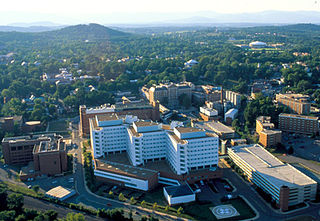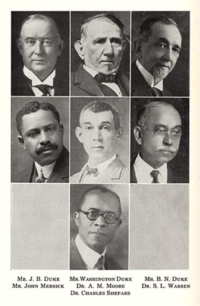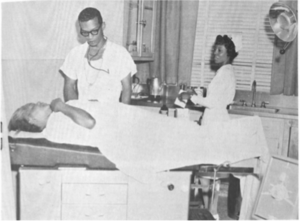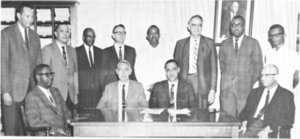
The Medical University of South Carolina (MUSC) is a public medical school in Charleston, South Carolina. It opened in 1824 as a small private college aimed at training physicians. It is one of the oldest continually operating schools of medicine in the United States and the oldest in the Deep South. The school's main building was designed by Charleston architect Albert W. Todd.

Matilda Evans, M.D., was the first African-American woman licensed to practice medicine in South Carolina and an advocate for improved health care for African Americans, particularly children.

The George Washington University Hospital is located in Washington, D.C. in the United States. It is affiliated with the George Washington University School of Medicine and Health Sciences. The current facility opened on August 23, 2002, with 371 beds in a 400,000 sq ft building, housing more than $45 million of medical equipment and costing over $96 million to construct. The hospital is licensed by the District of Columbia Department of Consumer and Regulatory Affairs and accredited by the U.S. Joint Commission.

The University of Arkansas for Medical Sciences (UAMS) is part of the University of Arkansas System, a state-run university in the U.S. state of Arkansas. The main campus is located in Little Rock and consists of five colleges including one graduate school, seven institutes, a statewide network of community educational centers, and the UAMS Medical Center.

The Brody School of Medicine (BSOM) is the medical school at East Carolina University, located in Greenville, North Carolina, United States. It is the newest of the four medical schools in North Carolina and a national leader in family medicine. Brody is ranked No. 1 in North Carolina and No. 2 nationally in the percentage of graduates who choose careers in family medicine, based on the 2017 American Academy of Family Physicians report on MD-granting medical schools. Brody ranks in the top 10 percent of U.S. medical schools for graduating physicians who practice in the state, practice primary care and practice in rural and underserved areas. Brody graduates currently practice in 83 of North Carolina's 100 counties.

Harlem Hospital Center, branded as NYC Health + Hospitals/Harlem, is a 272-bed, public teaching hospital affiliated with Columbia University. It is located at 506 Lenox Avenue in Harlem, Manhattan, New York City and was founded in 1887.
Duke Regional Hospital (DRH), located in northern Durham, North Carolina is a general-services hospital that has been part of the Duke University Health System since 1998. The hospital has 369 beds and over 500 physicians on the medical staff, and has a certified Level II Intensive Care Nursery.
Spartanburg Regional Healthcare System(SRHS) is one of South Carolina's largest healthcare systems. SRHS draws patients primarily from the areas of Spartanburg, Cherokee, Union and Greenville counties, located in the Piedmont region of South Carolina, and Rutherford and Polk counties, located in western North Carolina. Spartanburg General Hospital was organized under the authority of the South Carolina General Assembly in 1917, and officially became the Spartanburg Regional Health Services District, Inc., a political subdivision of the State of South Carolina, by charter granted by the secretary of state of South Carolina on May 1, 1995.

The Duke University Health System, combines the Duke University School of Medicine, the Duke University School of Nursing, the Duke Clinic, and the member hospitals into a system of research, clinical care, and education.

The University of Virginia Health System is an academic health care center associated with the University of Virginia in Charlottesville. The health system includes a medical center, school of medicine, school of nursing, and health sciences library. The health system provides inpatient and outpatient care and patient education and conducts medical research and education.

Cherry Hospital is an inpatient regional referral psychiatric hospital located in Goldsboro, North Carolina, United States. As one of three psychiatric hospitals operated by the North Carolina Department of Health and Human Services, it provides services to 38 counties in the eastern region of North Carolina. It is part of the Division of State Operated Healthcare Facilities within the Department of Health and Human Services, which oversees and manages 14 state-operated healthcare facilities that treat adults and children with mental illness, developmental disabilities, and substance use disorders. The Division's psychiatric hospitals provide comprehensive inpatient mental health services to people with psychiatric illness who cannot be safely treated at a lower level of care.

Watts Hospital, located in Durham, North Carolina was the city's first hospital, operating between 1895 and 1976.

Lincoln Community Health Center (LCHC) is an outpatient primary care facility located in Durham, North Carolina that replaced Lincoln Hospital in 1968. LCHC offers a wide range of health services including adult medicine, pediatrics, dental, social work/mental health services, family care nursing and outreach into the home. Prenatal and family planning services are available at the Center in cooperation with the Durham County Health Department.

Duke University Medical Center is a 938-acute care bed academic tertiary care facility located in Durham, North Carolina. Since its establishment in 1930, the hospital has grown from a small regional hospital to a world-renowned academic medical center. Duke University Hospital is the flagship teaching hospital for the Duke University Health System, a network of physicians and hospitals serving Durham County and Wake County, North Carolina, and surrounding areas, as well as one of three Level I referral centers for the Research Triangle of North Carolina.
George Washington Watts was an American manufacturer, financier and philanthropist. Alongside James B. Duke, he co-founded the American Tobacco Company, as well as Watts Hospital, the first hospital in Durham, North Carolina, which prompted the establishment of Duke University.

Charles DeWitt Watts was an African American surgeon and activist for the poor. Watts was the first surgeon of African American ancestry in North Carolina. Earning his medical degree in 1943 from Howard University College, he was the first African American board certified surgeon to serve in North Carolina. After surgical training at Freedman's Hospital in Washington, D.C. in 1949, he moved to Durham, North Carolina in 1950 and established a clinic to provide access to medical services for the poor. Breaking the social customs of racial obstacles, he advocated for certification of African American medical students. He also became a member of many professional colleges including the National Academy of Science's Institute of Medicine and the American College of Surgeons. He served as chief of surgery at Durham's Lincoln Hospital and was later one of the key figures in converting it to the Lincoln Community Health Center, a low-priced clinic for the poor.
Mary Lee Mills was an American nurse. Born into a family of eleven children, she attended the Lincoln Hospital School of Nursing and graduated in a nursing degree and became a registered nurse. After working as a midwife, she joined the United States Public Health Service (USPHS) in 1946 and served as their chief nursing officer of Liberia, working to hold some of their first campaigns in public health education. Mills later worked in Lebanon and established the country's first nursing school, and helped to combat treatable diseases. She was later assigned to South Vietnam, Cambodia and Chad to provide medical education.

Emma Ann Reynolds (1862-1917) was an African-American teacher, who had a desire to address the health needs of her community. Refused entrance to nurses training schools because of racism, she influenced the creation of Provident Hospital in Chicago and was one of its first four nursing graduates. Continuing her education, Reynolds became a medical doctor serving at posts in Texas, Louisiana and Washington, D.C. before permanently settling in Ohio and completing her practice there.

Florida A&M Hospital (1911-1971) was the first institution in Florida providing medical care to African Americans, who, during the segregation period, were not permitted to receive care at whites-only hospitals. There was no other such institution within 150 miles (241 km.) of Tallahassee. In 1940, "less than a dozen" counties in Florida had hospital facilities for Negroes.
![Lincoln hospital emblem. "Nisi Dominus Frustra", "if not the Lord, [it is] in vain." LHLogo.jpg](http://upload.wikimedia.org/wikipedia/commons/b/b2/LHLogo.jpg)






























